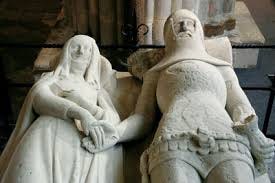#33: An Arundel Tomb

In my poetry group, Philip Larkin has a special place in the hearts of its members. He does not do pyrotechnics like Auden, nor profundity like Eliot, nor romantic spiritualism like Yeats. He just does words, unspectacular words that he turns into phrases and the phrases induce the steadiest meditations of the heart and mind. Here is a beautiful love poem, set in a most unexpected medium.
An Arundel Tomb
Side by side, their faces blurred,
The earl and countess lie in stone,
Their proper habits vaguely shown
As jointed armour, stiffened pleat,
And that faint hint of the absurd—
The little dogs under their feet.
Such plainness of the pre-baroque
Hardly involves the eye, until
It meets his left-hand gauntlet, still
Clasped empty in the other; and
One sees, with a sharp tender shock,
His hand withdrawn, holding her hand.
They would not think to lie so long.
Such faithfulness in effigy
Was just a detail friends would see:
A sculptor’s sweet commissioned grace
Thrown off in helping to prolong
The Latin names around the base.
They would not guess how early in
Their supine stationary voyage
The air would change to soundless damage,
Turn the old tenantry away;
How soon succeeding eyes begin
To look, not read. Rigidly they
Persisted, linked, through lengths and breadths
Of time. Snow fell, undated. Light
Each summer thronged the glass. A bright
Litter of birdcalls strewed the same
Bone-riddled ground. And up the paths
The endless altered people came,
Washing at their identity.
Now, helpless in the hollow of
An unarmorial age, a trough
Of smoke in slow suspended skeins
Above their scrap of history,
Only an attitude remains:
Time has transfigured them into
Untruth. The stone fidelity
They hardly meant has come to be
Their final blazon, and to prove
Our almost-instinct almost true:
What will survive of us is love.
The sarcophagus rests in Chichester Cathedral, West Sussex. Antiquarians are fairly certain it is that of Richard FitzAlan, 10th Earl of Arundel (d. 1376), and his second wife, Eleanor of Lancaster (d. 1372). It was erected at Lewes Priory and transferred to Chichester in 1537 on the dissolution of the priory. The token of their love, their handholding has been on view for nearly 650 years.
Larkin does a terrific job. The initial plainness of the stone, then a ‘sharp, tender shock’ as the viewer’s gaze takes in the handclasp. He thinks the husband and wife expected the ‘sweet commissioned grace’ to be but a detail for their loved ones. But no, their pose has held its strength ‘through lengths and breadths of time’. Undated winters and summers, endlessly the people, altered, came. Now, ‘only an attitude remains’. The stone fidelity is their final blazon, their everlasting identity…
‘…and to prove/Our almost-instinct almost true:/What will survive of us is love.’ Larkin can hardly believe his inevitable conclusion, but it is there right in front of him – and has been there for six and a half centuries. He HAS to say it – ‘What will survive of us is love.’
Certainly, in this chance-ridden world many different fates may overcome us, and love may not survive of us. But in Chichester Cathedral there is proof positive that it has. How many icons of hatred have survived similarly?
My wife, Robin, and I visited Chichester Cathedral a few years ago; I read the poem to her as she sat gazing at the handclasp. Our tears then attested to the survival of our love. And its legacy.


